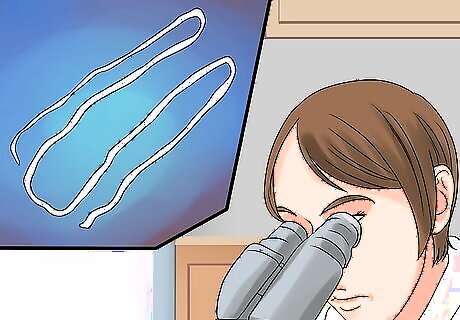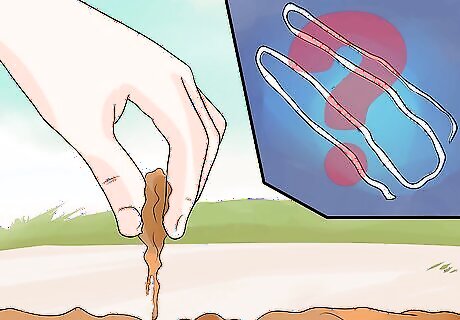
views
X
Trustworthy Source
Centers for Disease Control and Prevention
Main public health institute for the US, run by the Dept. of Health and Human Services
Go to source
Checking for the Symptoms of Infection

Make a note of increased upset stomach. These could be signs of the infection or other problems, but they are a potential warning. Increased occurrences of nausea and/or diarrhea could be symptoms of dwarf tapeworm infection. You may also experience abdominal pain along with the upset stomach. The severity of your symptoms could vary greatly. Duration of these symptoms could be from a few days to intermittently over years.

Check if you have a loss of appetite. This too can be a sign of the tapeworm infection or other problems. As this is not as an immediate symptom as nausea or diarrhea, you may want to take a few days to make sure this is occurring. Weight loss is rarely an occurrence with dwarf tapeworm infection. See if you are turning away even your favorite foods. There is a risk of vitamin deficiency and body chemistry imbalance with this, so consult your doctor if it persists.

Feel if you have any abdominal pain. While you cannot feel the worm inside you, the subsequent infection can induce pain. If the pain is intense, see a doctor immediately in case it is a symptom of something else. This pain could vary in intensity from and duration from immediately of a few days to on and off for years depending on the persistence of infection. If you can identify the pain as acute (sharp and intense) and/or chronic (frequent occurrence)--this may help your doctor's diagnosis. The pain's location may not situate itself in any one location in the abdominal area. Similar to the other conditions, it could be a symptom of the tapeworm infection, or other problems.

Be aware of any itches around the anal region. This could be a sign of localized infection and irritation and it is most common in young children. The irritation could also vary in intensity and duration depending on the timeline of the infection. A rash or physical blemish is not typically associated with this irritation, though you may risk inflicting such harm if you scratch too much.

Determine if you have intense headaches. This could be a sign of a more severe infection and this symptom is also seen in young children more often. If you feel the headache in conjunction with the other symptoms, this too could be signs of other illness--but the tapeworm infection remains a possibility. The headache's intensity and duration may vary greatly depending on the persistence of the infection. There are ways to classify your pain level, if it's sharp and severe (acute) or frequent (chronic). This can be useful to your doctor for diagnosis.

Pay attention to loss of sleep. Problems sleeping can be signs of a more severe infection. Similar to loss of appetite, you should see if this pattern holds up over a few days to determine if it's an actual symptom of your problem. Sleep loss caused by an associated problem is called "secondary insomnia" (as opposed to ordinary sleep loss or "primary insomnia"). As with pain problems, this can be acute (brief intense bouts) and/or chronic (frequently occurring). Let your doctor know how you are being affected. Besides waking up at night, you might experience sleepiness during the day, fatigue (tiredness), irritability (bad mood), and problems concentrating/memory. Any repeated disruption to your normal sleeping period can be a symptom of insomnia, but determining the cause may be up to your doctor and you.
Learning Sources of the Infection

Identify locations the dwarf tapeworms may have placed eggs. Finding places where exposure could have happened can help with diagnosis, and prevent further contamination. These eggs are frequently passed through accidental ingestion. Fecal contamination is a possibility especially in poor sanitary/hygiene areas. You may not be able to visibly spot the eggs. While the worms can grow up to a couple of inches in length, the eggs will need medical instrumentation to detect.

Ask if others have been infected around you. You may have come in contact with the same substances they have. See what they ate, drank, or touched of an organic nature that may have been a carrier for the eggs.

Examine the possibility of secondary hosts. See if another animal or insect have been exposed and carried the infection into local consumables. Sometimes these other animals and insects will eat the eggs and then contaminate the food, water, and/or soil supply indirectly. The infection can spread by one consuming the intermediate host. The intermediate host may not show any obvious signs of infection. Contact an entomologist (expert on insects) either locally or if one can be reached at a nearby university for assistance on identifying infected insects in the area. Consult local environmental reports to see if any infections are reported. Ask your local forestry, or game and wildlife service to see if any animals in the area have been infected with tapeworms.

Determine if local soil has been exposed. If you do any yard or farm work, this is especially important. Accidentally ingesting some contaminated soil by putting your fingers to your mouth can lead to infection. Fecal contamination is a risk as the reproducing worm and eggs can pass through the bowels. Ask government agencies for reports on potential contamination. Get independent verification if possible. See if there are any environmental groups that work in the area and have contaminant information. Also independently verify their data if possible.

Examine potentially exposed water supplies. This is of even greater concern in poor sanitation/hygiene areas. As with the food supply and soil, this is an at risk area for exposure to the eggs and fecal contamination from intermediate hosts. Ask to see if others have been infected from a particular water supply. File requests with the local government to get reports on the environmental health of the water supply. Independently verify the data with other sources if possible. Check with local environmental groups to see if they have been monitoring contamination of water supplies. But independently verify the data.
Seeking Treatment for the Infection

Go to a doctor to confirm if you have a dwarf tapeworm infection. A fecal examination is the usual way this diagnosis is made. Diagnosis is made by identifying the eggs in the fecal stool. Your doctor will ask you to submit specimens collected over several days confirm if you are infected or not.

Take the prescribed treatment. Usually the drug praziquantel is given for dwarf tapeworm infections. Praziquantel dissolves the dwarf tapeworm within the intestine. Praziquantel is usually well tolerated. Sometimes more than one treatment is necessary--up to ten days. Follow your doctor's instructions when taking praziquantel. But usually it is taken by mouth, with food, three or four times a day (four to six hours apart). You should take the medicine with a full glass of water. Do NOT chew or suck the medicine tablets. You should avoid consuming grapefruits or grapefruit products while taking praziquantel. Contact your doctor immediately if your condition persists or worsens. Sometimes Niclosamide or nitazoxanide are given as alternative medicines. Follow your doctor's instructions when taking any of these medicines.

Know the prognosis of dwarf tapeworm infections. This disease is relatively minor if treated on time. Most patients fully recover with treatment. More severe symptoms can result from prolonged infections, so treatment should be sought immediately.

Learn how to prevent infection while you are infected. You do not want to spread the infectious eggs while you are receiving treatment. If you have multiple bathrooms at home, consider using one while your family/guests use the other. Disinfect any bathroom equipment you use thoroughly after every use. Standard antibacterial sprays and soaps should be sufficient, but ask your doctor if they recommend something else. Consider leaving food preparation to others until your doctor certifies you as clear of the infection. Have an independent/portable food and water supply if you are traveling.

Maintain prevention of infection. Improving hygiene and sanitation not only can help prevent spreading the infection from a contaminated person, but prevent infection in the first place in the future. Wash your hands with soap and warm water. Do this after any task involving potential contaminants--especially after using the toilet, diaper changes, and during food preparation. Be particularly mindful of educating children in your area about cleanliness around potential contaminants--especially with their higher risk for dwarf tapeworm infection. If you are in a situation where food may be contaminated, you should wash, peel and/or cook all raw vegetables and fruits with safe/tested water before eating.




















Comments
0 comment